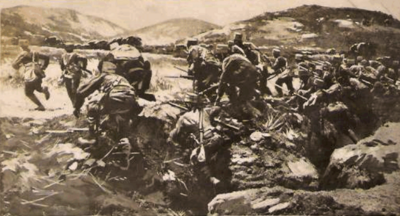Ruvelkan-Symmerian War
| Ruvelkan-Symmerian War | |||||||
|---|---|---|---|---|---|---|---|
 | |||||||
| |||||||
| Belligerents | |||||||
|
|
| ||||||
| Commanders and leaders | |||||||
|
|
| ||||||
| Units involved | |||||||
| Ruvelkan Red Army | Army of Symmeria | ||||||
| Strength | |||||||
| 650,000 troops | 445,000 troops | ||||||
| Casualties and losses | |||||||
|
165,000 killed 300,000 wounded |
75,000 killed 190,000 wounded | ||||||
The Ruvelkan-Symmerian War (Syaran: Рувелкан-македонска војна) was an armed conflict fought between the Ruvelkan Socialist Republic and the Kingdom of Symmeria from 12 September 1872 to 6 May 1873. It's immediate causes were territorial disagreement over the status of the disputed Imerti territory and the Symmerian-Ruvelkan Border, while Ruvelkan leadership were also hopeful that the arrival of the Red Army would instigate a socialist-inspired uprising among the Symmerian peasantry and working class.
The Ruvelkan Red Army began by invading eastern Symmeria in September 1872, crossing the Lushan Rivers and seizing control of Vashryn and Jisova along the coastline of the Sundering Sea. A subsequent Ruvelkan drive on Gbevec in was halted and in October, followed by a Symmerian sweeping offensive that trapped Ruvelkan forces across the West Lushan River. Fighting around the East Lushan River lasted until November, which forced the Ruvelkans to withdraw back across the border. The Ruvelkans assumed the fighting would cease for the winter, but on 8 December the Symmerians launched a surprise invasion of both Zemplen and northern Ruvelka. In January 1873 the Symmerians captured Sopron, and in February had laid siege to Kaposvar. In March the Ruvelkans launched a counter-offensive into Zemplen to repel the Symmerians, but were defeated and the region fell under complete Symmerian control. In April a relief effort failed to break the siege of Kapsovar and the city fell into Symmerian hands. In May the Symmerians began pushing towards Kunhegyes, resulting in a final clash with the Red Army before a ceasefire was agreed to.
The war officially concluded on 6 May 1873 under terms that heavily favored the Symmerians. Symmeria gained control of Imerti and Zemplen while the Ruvelkan Red Army had been dealt a serious blow in prestige and the loss of many skilled officers. Symmeria's victory over Ruvelka allowed it to take a dominant role in the Unification of Syara, which occurred just two years after the war ended and was driven heavily by a desire to ensure Syaran independence and security in the face of Ruvelkan aggression. Ruvelka's defeat ended the leadership of Premier András Váradi, who was blamed for Ruvelka's defeat. The loss of Zemplen and Imerti to the Syarans would remain a point of national frustration for Ruvelka, which would eventually lead to a series of territorial conflicts between the two nations.
Background
The origin of the conflict was born out of multiple causes, predominantly territorial and ideological. The border between Ruvelka and Syara had long been an issue of contention since the dissolution of the Rioni Union, with disputes over the regions of Imerti and Zemplen a particular source of conflict between both nations. In 1843 the Kingdom of Galania had attempted to reclaim Zemplen from the Ruvelkan Imperium in order to improve it's standing among the Syaran Successor States, but had been defeated. The war signaled the end of Galanian dominance among the Syaran states, while the damage inflicted by the fighting weakened the already declining Imperium. This paved the way for the rise of the Ruvelkan Red Faction which culminated in the Red War and established the Ruvelkan Socialist Republic.
Not long after the formation of the Ruvelkan SR did the Ruvelkan Communist Party began pushing for revolutionary movements in neighboring nations. Two primary targets for the Proletariat Revolution were the monarchies of Galania and Symmeria, the latter which had established itself as the principle Syaran state in the aftermath of Galania's decline. The success of the Ruvelkan Revolution in turn triggered communist-inspired public movements and protests in both states between 1867-1869, with the Symmerian Kingdom violently suppressing the revolt within their borders. The harsh crackdown instituted by the Symmerians surprised communist Ruvelkan leadership, who had not expected such a strong reaction from the Symmerian government. The action instantly transformed the perception of Symmeria in the eyes of the Ruvelkan SR as the principle opponent to the international revolution; in a letter penned by András Váradi to party officials in 1870, he identified Symmeria as the "source of reactionary autocracy that stands itself against the proletariat, continuing a tradition of oppression that has persisted for 2,000 years".
In Symmeria, traditional distrust of Ruvelka was only exasperated by the communist revolution. Efforts by the Ruvelkan Communist Party to trigger international revolutions across Tyran, both covertly and overtly, quickly earned the condemnation of the Zelusian Dynasty. For the Symmerians, the threat of communist insurrection was both a domestic and international concern given the close proximity of the Ruvelkan SR, and the size of the Ruvelkan Red Army. The notion of a Ruvelkan inspired or funded revolution, backed up by the involvement of Ruvelkan military forces, led to considerable concern inside the Symmerian capital of Parilla. King Dzvonko I in particular voiced repeated concerns of the threat of Ruvelkan aggression against the Kingdom and as early as 1866 ordered the Royal Staff to prepare contingencies for a conflict with Ruvelka.